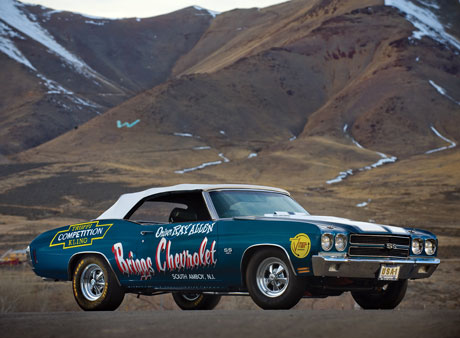SCM Analysis
Detailing
| Vehicle: | 1970 Chevrolet Chevelle SS LS6 |
| Years Produced: | 1970 |
| Original List Price: | $4,800 |
| Tune Up Cost: | $400, including valve lash adjustment |
| Distributor Caps: | $14.99 |
| Engine Number Location: | Pad below front edge of right side cylinder head |
| Club Info: | American Chevelle Enthusiasts Society (ACES); The Supercar Registry/ The Yenko Sportscar Club |
| Website: | http://www.chevelles.com |
This 1970 Chevelle SS 454 LS6 Convertible sold for $264,000, including buyer’s premium, at RM’s Icons of Speed & Style auction in Los Angeles, California, on September 26, 2009. It previously sold for $1,242,000 on January 14, 2006, at the Barrett-Jackson auction in Scottsdale (SCM# 40317).
This Chevelle SS 454 became the new poster child for “gloom and doom” muscle car analysts within seconds of this sale. After all, the consignor took a cool million-dollar haircut on this car in under four years. But the last time it sold, at Barrett-Jackson Scottsdale 2006, this LS6 instantly raised the bar on muscle car prices, so it represents an extreme case of extreme swings in the market.
Not much of the NHRA champion was left
Let’s look at more of its history. Once it was out of sanctioned Super Stock racing in 1972, it was treated like any other old drag car-they just kept hacking at it to make it faster. When purchased by Ray Allen in the 1980s in Georgia, not much of his original NHRA Champion was left.
The B-J consignor, a well-known broker/dealer from SoCal, purchased the car from Ray Allen in a semi-restored state. And therein lies the rub. The Ray Allen car falls into the gray area between original cars with no fame, and famous race cars that were preserved as testaments to their crowning achievements. As found, this LS6 was not in the same configuration as the car that won the 1970 Supernationals, nor was it a well-preserved stock 1970 LS6 convertible, of which fewer than 20 were produced.
Such was the dilemma that faced the 2006 B-J consignor. The car was being restored by Allen to stock LS6 trim, but it didn’t have original sheetmetal, the original drivetrain was gone by 1971, and the base car was a column-shift automatic LS6-not the ultimate version by any means.
The value was in its race history, but what arrived at B-J was a restored street car with a vintage drag car appearance. Under the hood was a replacement motor dressed as a stock LS6 unit, with none of the period NHRA-legal speed parts or internal modifications that would enable it to leave the polo field with the front wheels hung high. The race lettering and sponsorship logos were decals, easily removable so the car could be used on the street, and not hand-painted as they were in 1970.
It’s hard to get excited about a wheezing drag car
The restoration was decent, but it had driver-level paint and fit and alignment issues. Even the tires were just modern drag racing tires and not proper vintage slicks ‘n skinnies that would have really given the car the right look. And it’s hard to get excited about a drag car that wheezes onto the stage. More telling perhaps was that the 2006 consignor hoped the car would bring around $400k-little more than a stock LS6 convertible at the time.
So when two determined, high-profile bidders decided to duke it out on Speed TV and the hammer dropped at $1.15m plus commission, I knew the best way to get free drinks was to follow that consignor around for the rest of the night. It was a completely over-the-top price based solely on two people fighting it out to the bitter end. The value wasn’t based on the car but on its history. Instantly this result pushed LS6 values up 30%.
Which leads me to my opinion on the two high-profile sales of this particular SS 454 LS6 Convertible. The first sale at B-J was easily 50% higher than any logical value, while the sale at RM at $264k was a very good buy for an end user.
Why so cheap? Anyone who can count can figure the world’s economic crisis and the roughly 30% decline of the collector car market was a contributing factor. And if there is a market that has been hit harder than muscle cars, it has to be vintage drag cars. The market has been flooded with historically significant drag cars and prices are in the tank. Besides, unless you have a museum or a private drag strip, you can’t really use them; you can’t throw the kids in the back and head to Bob’s Big Boy cruise night.
My advice for the new owner of this LS6 is to call up Ray Allen and pay him to help you make the car exactly as it was when he last raced it. Scour eBay for an Edelbrock Tarantula intake, vintage slicks, and Hooker headers. Have the motor built back up to NHRA-legal Truppi-Kling specs. Find a retired sign painter who can hand-letter the graphics. Make sure the car is safe, tuned right, hooks hard, and goes straight. Then call me so I can help you get it to the Supercar Reunion next year and we can make a dozen passes and see if she’ll still run 11-flats. Well bought.
